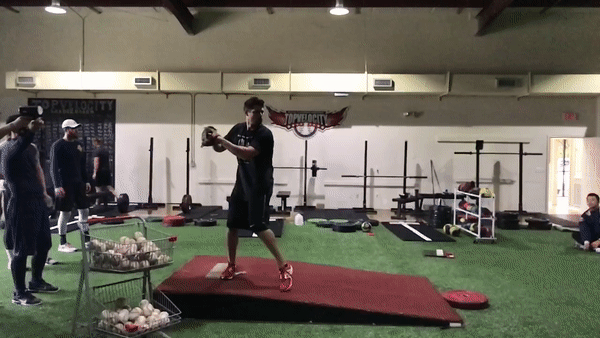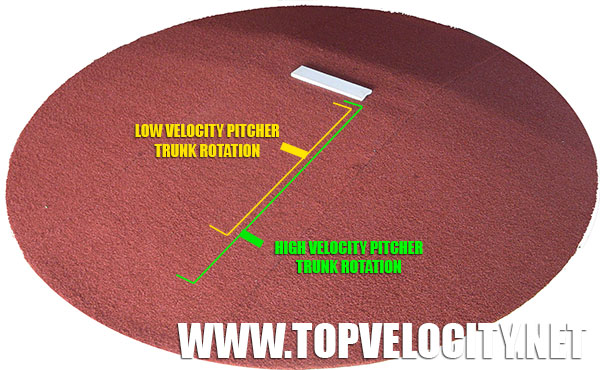It is proven that high velocity pitcher has more dynamic trunk movements than low velocity pitchers (1). More important is when the trunk initiates movement in the pitching delivery. This timing of trunk rotation is critical when it comes to increasing arm speed.
Arm speed programs that do not address the pelvic and trunk movements before initializing the arm will have little effect on developing the high velocity pitcher. This is the problem with Extreme Long Toss programs for pitching velocity. With Extreme Long Toss it has been proven to reduce the dynamic trunk movements of the throw when the distances increase (2).
In this article, I will cover the findings of the trunk rotation and arm speed study, how the high velocity pitcher generates dynamic trunk movement and especially the timing of this dynamic trunk movement to reduce arm stress and increase arm speed.
Effects of Trunk Rotation on The Shoulder Among Pitchers
This study performed at the Children’s Hospital in San Diego by Arnel L. Aguinaldo, Janet Buttermore, and Henry Chambers found that trunk rotation timing is significantly correlated to decreased torques on the throwing arm and increased ball speed (3). This is important because high rotational torques during baseball pitching are believed to be linked to most overuse injuries at the shoulder. These overuse injuries to the shoulder and elbow joints remain the most common medical problem in all levels of baseball.
The problem with developing the high velocity pitcher is that a high level of joint load on the arm is needed to generate the torques necessary to produce high amounts of arm speed. Therefore injury is a major problem at the top level of the game. This is why studies like this one that prove you can decrease the loads on the shoulder joint while also increasing pitching velocity are priceless to the pitching community with the growing epidemic of arm problems today. An important approach behind all of this is the speed principle.
Speed Principle
This is an action in which a segment initiates its movement when the adjacent proximal segment reaches its maximum angular velocity (4).
To truly understand this principle you need to first understand how the kinetic chain functions within the high velocity pitching delivery.
Efficient throwing mechanics is predicated on a pitcher’s ability to perform a sequence of movements in body segments, which progresses from the legs, pelvis, and trunk to the smaller, distal arm segments. The momentum generated by the larger segments is transferred to the adjacent distal segments by appropriately timing the movement of the pelvis and trunk in a manner that ideally follows the summation of the speed principle.
This means the pitcher starts the movement in the legs and the pelvis does not start its movement until the legs have peaked forces. This process then continues into the trunk, shoulders and arm. Any break in this process will cause the pitcher to overcompensate up the kinetic chain which will increase the loads and torques on the arm.
Another study also proved the critical importance of using the speed principle to help reduce the wear and tear on the arm while also increasing pitching velocity (5). I wrote an article on this timing factor called, Study Proves Timing Increases Ball Speed While Reducing Injury.
Now that we understand the importance of the timing of the body segments let's look at how the trunk movements effected shoulder torques and ball speed in this case study (3).
No significant kinematic differences in trunk movement were found across all four groups of pitchers except for the starting time of trunk rotation, defined as the onset time of peak trunk rotation. Professional pitchers rotated their torsos toward home plate much later in the pitch cycle (34 ± 5%, p = .01) compared with lower level pitchers, who rotated at an average below 14% into the pitching cycle.
The absolute magnitudes of internal rotation torque differed significantly among all four pitching levels, with youth pitchers exhibiting the least amount of internal rotation torque (33 ± 3 N•m) as compared with high school (66 ± 6 N•m, p < .001) and collegiate (78 ± 9 N•m, p < .001) pitchers. Professional level pitchers threw with less internal rotation torque (50 ± 9 N•m) than collegiate pitchers (78 ± 9 N•m, p = .04). When analyzing rotation torques normalized by body weight and height (Figure 4), professional pitchers exhibited significantly less normalized peak torque (25 ± 3% BW•H) than pitchers from the college (43 ± 5% BW•H, p = .01), high school (49 ± 5% BW•H, p = .003), and youth (40 ± 3% BW•H, p = .02) levels.
So now that we have proof that late trunk rotation will increase arm speed while reducing stress on the arm let's learn how to implement it into the pitcher delivery. It is important to know that it has been presumed that even slight changes in trunk timing could result in reduced output and potentially harmful joint loads at the throwing shoulder (Fleisig et al., 1996).
Developing Late Trunk Rotation in the Pitcher
 This clip of Cody Hall moving through his high velocity delivery is a great representation of late trunk rotation. He is keeping his trunk from rotating until front foot strike. The problem is when most viewers see this kind of delivery they believe the way to replicate this late trunk movement is through the shoulders.
This clip of Cody Hall moving through his high velocity delivery is a great representation of late trunk rotation. He is keeping his trunk from rotating until front foot strike. The problem is when most viewers see this kind of delivery they believe the way to replicate this late trunk movement is through the shoulders.
The only way you can create this kind of late trunk rotation is with the hips not the shoulders. View the picture of the pitching mound below. The thick yellow line shows when the low velocity pitcher rotates his trunk and the thick green line shows when the high velocity pitcher rotates his trunk.
If you would stop the low velocity pitcher in his delivery at the thick yellow line then you could see that the lift leg is open towards the target and the drive leg is collapsing before leg drive. This is why their trunk is rotating early because the hips are rotating early. If you would stop the high velocity pitcher at the thick green line then you would see a more closed front leg and a more stable drive leg starting to triple extend to peak ground reaction forces which leads to early hip rotation just before front foot strike and late trunk rotation as the shoulders catch up with the hips.

To start learning how to prevent the opening of the lift leg too early in the pitching delivery and the collapsing of the drive leg too early in the pitching delivery, I would highly recommend that you signup for the FREE 3 Part Video Series on 30 Days to 5MPH. In this video series you will learn about the Force Vector and how the high velocity pitcher peaks ground reaction forces later in the pitching delivery to create early hip rotation just before front foot strike which leads to late trunk rotation in the pitching delivery.
Reference:
- Stodden DF, Fleisig GS, McLean SP, Lyman SL, Andrews JR. - Relationship of pelvis and upper torso kinematics to pitched baseball velocity. - Journal of Applied Biomechanics 17(2):164-172, 2001.
- Fleisig GS, Bolt B, Fortenbaugh D, Wilk KE, Andrews JR. - Biomechanical comparison of baseball pitching and long-toss: implications for training and rehabilitation. - American Sports Medicine Institute, 833 St. Vincent’s Drive, Suite 100, Birmingham, AL 35205, USA. - J Orthop Sports Phys Ther. 2011 May;41(5):296-303.
- Journal of Applied Biomechanics, 2007; 23:42-51. - Effects of Upper Trunk Rotation on Shoulder Joint Torque Among Baseball Pitchers of Various Levels. - Arnel L. Aguinaldo, Janet Buttermore, and Henry Chambers. - Children’s Hospital San Diego.
- Putnam, C.A. (1993). - Sequential motions of body segments in striking and throwing skills: descriptions and explanations. - Journal of Biomechanics, 26(Suppl. 1), 125-35.
-
M.A. Urbin, PhD, Glenn S. Fleisig, PhD, Asheber Abebe, PhD, and James R. Andrews, MD. – Associations Between Timing in the Baseball Pitch and Shoulder Kinetics, Elbow Kinetics, and Ball Speed. – Investigation performed at the American Sports Medicine Institute, Birmingham, Alabama. – Am J Sports Med 2013 41: 336



